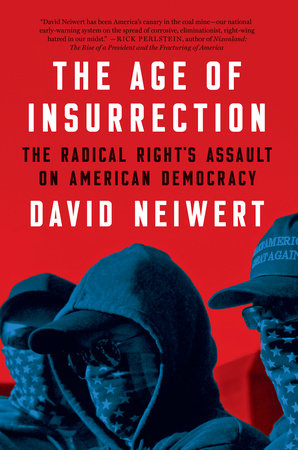The Age of Insurrection: The Radical Right’s Assault on American Democracy
- By David Neiwert
- Melville House
- 544 pp.
- Reviewed by Sunil Dasgupta
- August 9, 2023
What’s fueling this pernicious, illiberal fire?

Hillary Clinton’s famous accusation of a “vast right-wing conspiracy” brought together two disparate images: a finite cabal and a notion of the infinite. Though she was primarily concerned about the conspiracy’s political threat to her husband, it was already clear in the late 1990s that America’s right-wing movement had multiple branches that included terrorist bomber Timothy McVeigh, anti-abortion militant Randall Terry, conservative lawyer Kenneth Starr, and billionaire publisher Richard Mellon Scaife.
Since then, the roots, stems, creepers, leaves, flowers, seeds, tendrils, and thorns of the movement that is far-right politics have spread like the forest over Chernobyl’s melted nuclear reactors, making journalist David Neiwert’s effort to capture the scope of its assault on American democracy hard to contain in the 500 pages of The Age of Insurrection.
In the book, Neiwert draws a line from McVeigh to contemporary radical groups such as militant pro-lifers and QAnon; from Rambo-like young white men discharged from the military to the Proud Boys, Oath Keepers, and Three Percenters; and from Donald Trump’s dog-whistling calls for insurrection to those answering it. He chronicles in detail these groups’ networking, building, fracturing, and eventual reforming under new names.
The Proud Boys, for example, was initially a male social club of “Western chauvinists who refuse to apologize for the creation of the modern world” started by Gavin McInnes, a founder of the media group Vice. A street fight with opponents at a Milo Yiannopoulos event at Berkeley in 2017 transformed the group into a black-and-yellow-shirted paramilitary force that provides security to right-wing speakers. Yiannopoulos, a far-right provocateur, saw his public profile take wing during Trump’s ascendance, although he has since crashed back to earth.
The Proud Boys eventually split, with McInnes leaving and leadership passing to Enrique Tarrio, who is pointedly not white. The group achieved peak prominence during an infamous presidential debate between Trump and Joe Biden during which Trump told the Proud Boys to “stand back and stand by.” The group was expected to play an important role on January 6th, but Washington, DC, police arrested Tarrio the day before the insurrection on charges stemming from a prior offense, when the Proud Boys destroyed a Black Lives Matter banner belonging to a city church.
A charismatic 33-year-old Portland, Oregon, man, Joey Gibson, who’d attended Yiannopoulos’ Berkeley melee, went on to found Patriot Prayer, a group that worked the streets alongside the Proud Boys but became even more radical and violent and has set a new pattern for brawls with so-called Antifa (short for anti-fascist) activists. Neiwert shares similar stories of other such groups, including the Boogaloo Bois (who made the Hawaiian shirt into a paramilitary uniform), the Nick Fuentes-led Groypers (who popularized the Pepe the Frog meme), the Patriot Front, and Identity Europa.
Neiwert’s description of the radical right — its groups, their interconnections, and their machinations — certainly leaves an impression of a vast conspiracy (like Clinton articulated), but it also begs a question. If indeed something is truly vast, can it really be conspiratorial, a secret plan among a restricted group?
Liberal thinking about right-wing politics has long been informed by the work of historian Richard Hofstadter, who wrote an essay called “The Paranoid Style in American Politics” in Harper’s in 1964. Hofstadter is close to Clinton in his relative emphasis on conspiracies, yet he, too, had a problem explaining their vastness vis-à-vis their presumed secrecy. Like Neiwert does with January 6th, Hofstadter looked back from the (for him) contemporaneous conspiracies surrounding JFK’s assassination to identify analogous schemes, including McCarthyism, anti-Catholic and anti-Masonic campaigns, and the Illuminati, all of which point to a persistent American streak of “paranoid style.”
But two questions remain. Why is this phenomenon uniquely American? (It isn’t, of course. Consider Russian politics or the Dreyfus Affair in France.) And why does the paranoia surface only at certain times? Put another way, if the presence of conspiracy is a constant throughout American history, what explains the vastness of the radical right at this moment? Ask any organizer how hard it is to get 20 people to show up to a city hall protest and you’ll see why right-wing groups’ assembling of huge amounts of protestors during the Unite the Right rally in Charlottesville in 2017 and the January 6, 2021, assault on the U.S. Capitol was so remarkable.
Even with Neiwert (and Jack Smith, Fani Willis, and others) cutting through the forest to identify individual trees, however, it’s hard to find a single explanation for what’s fueling the current virulent unrest on the right. Is it just Trump? The oft-cited (though largely bogus) specter of economic insecurity? Disillusionment over the culture’s apparent shift to the left? Immigration? The “denigration” of white men? Covid? Facebook? The dark web?
There’s no one answer, although the best way to find something of an explanation may come from adopting the Woodward and Bernstein dictum: Follow the money. Above all else, right-wing vitriol thrives via the monetization of online charisma. Take the Groypers’ Fuentes. A big part of his influence comes from his ability to extract money (in furtherance of the “cause,” presumably) from followers. After the 2020 election, when he, Trump, incendiary conspiracy theorist Alex Jones, and others were deplatformed, we began to see a reduction in the noise — if not the vastness — of the right-wing-outrage enterprise.
The marketplace of ideas — like any other marketplace — needs regulation and accountability if the “age of insurrection” is to come to an end. For his part, Neiwert has said in interviews that he remains pessimistic about America’s future given the perniciousness of right-wing conspiracies. At least his informative, eye-opening book may help us learn to tame their vastness.
Sunil Dasgupta teaches politics and government at UMBC at the Universities at Shady Grove.

